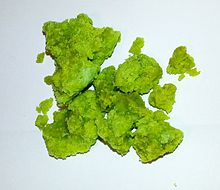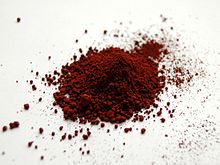| Revision as of 09:26, 26 December 2023 editDr Kavitha Koothireddy-Kota (talk | contribs)2 editsm Chemical reactivity of Fe+2Tag: Visual edit← Previous edit | Revision as of 14:16, 10 March 2024 edit undoSmokefoot (talk | contribs)Autopatrolled, Extended confirmed users, Pending changes reviewers, Rollbackers74,600 edits revised by making strictly parallel to iron(III) articleNext edit → | ||
| Line 2: | Line 2: | ||
| ] | ] | ||
| ] | ] | ||
| In ], '''iron(II)''' refers to the ] ] in its +2 ]. In ] (salts), such an atom may occur as a separate ] (positive ion) denoted by '''Fe<sup>2+</sup>'''. | |||
| {{Short description|The element iron in its +3 oxidation state}} | |||
| ⚫ | The adjective '''ferrous''' or the prefix '''ferro''' |
||
| ] contains the iron(III) complex {{chem2|(3-)}}.]] | |||
| ⚫ | In ], '''iron(II)''' refers to the ] ] in its +2 ]. The adjective '''''ferrous''''' or the prefix '''''ferro-''''' is often used to specify such compounds, as in ''ferrous chloride'' for ] ({{chem2|FeCl2}}). The adjective '']'' is used instead for ] salts, containing the cation Fe<sup>3+</sup>. The word '']'' is derived from the ] word {{wikt-lang|la|ferrum}}, meaning "iron". | ||
| Iron(II) atoms may also occur as ]es, such as the polymer ] ], {{chem2|''n''}} or {{chem2|\{2\}''n''}}; and ]s, such as the neutral molecule ], {{chem2|Fe(C2H5)2}} or {{chem2|2}}. | |||
| Ferrous ion Fe+2 and its salts are short lived and more prone for the air oxidation and immediately turned to the Ferric Fe+3 which in turn more stable. Hence in the Qualitative analysis of the salts Ferrous ion solution is not preferable to store rather we can prepare insitu. | |||
| In ] (salts), such an atom may occur as a separate ] (positive ion) abbreviated as '''Fe<sup>2+</sup>''', although more precise descriptions include other ligands such as water and halides. Iron(III) centres occur in ]es, such as in the ] ], {{chem2|(4-)}}, where six ] ligands are bound the metal centre; or, in ]s, such as the ] {{chem2|}}, where two ] anions are bound to the Fe<sup>II</sup> centre. | |||
| Iron is almost always encountered in the oxidation states 0 (as in the metal), +2, or +3. Solid iron(II) salts are relatively stable in air, but in the presence of air and water they tend to ] to iron(III) salts that include ] ({{chem2|HO(-)}}) or ] ({{chem2|O(2-)}}) anions. | |||
| ==Iron( |
==Iron(III) in biology== | ||
| All known forms of life require iron. Many ]s in living beings contain |
All known forms of life require iron.<ref>{{cite web | title = Iron integral to the development of life on Earth – and the possibility of life on other planets | url = https://www.ox.ac.uk/news/2021-12-07-iron-integral-development-life-earth-and-possibility-life-other-planets | date = 7 December 2021 | publisher = ] | accessdate = 9 May 2022}}</ref> Many ]s in living beings contain iron(III) centers. Examples of such ]s include ], ], and the ]s. In many of these proteins, Fe(II) converts reversibly to Fe(III) <ref>{{cite book |author=Berg, Jeremy Mark |author2=Lippard, Stephen J. |title=Principles of bioinorganic chemistry |publisher=University Science Books |location=Sausalito, Calif |year=1994 |isbn=0-935702-73-3 }}</ref> | ||
| ⚫ | Insufficient iron in the human diet causes ]. Animals and humans can obtain the necessary iron from foods that contain it in assimilable form, such as meat. Other organisms must obtain their iron from the environment. However, iron tends to form highly insoluble iron(III) oxides/hydroxides in aerobic (]ated) environment, especially in ]s. ] and ]es can thrive in such environments by secreting compounds called ]s that form soluble complexes with iron(III), that can be reabsorbed into the cell. (The other plants instead encourage the growth around their roots of certain bacteria that ] iron(III) to the more soluble iron(II).)<ref name=marsch94>H. Marschner and V. Römheld (1994): "Strategies of plants for acquisition of iron". ''Plant and Soil'', volume 165, issue 2, pages 261–274. {{doi|10.1007/BF00008069}}</ref> | ||
| These proteins perform their vital functions thanks to the relatively easy switching of the iron atom between the +2 and +3 states. Hemoglobin, for example, carries ] in the blood by binding one molecule {{chem2|O2}} to the iron atom, forming ]. In the process, the iron(II) core of hemoglobin loses an electron to become iron(III), while the oxygen molecule is turned into the ] anion {{chem2|O2(-)}}.<ref>{{cite book |author=Berg, Jeremy Mark |author2=Lippard, Stephen J. |title=Principles of bioinorganic chemistry |publisher=University Science Books |location=Sausalito, Calif |year=1994 |isbn=0-935702-73-3 }}</ref> | |||
| In contrast to iron(III) aquo complexes, iron(II) aquo complexes are soluble in water near neutral pH. Ferrous is however oxidized by the oxygen in air, converting to iron(III). | |||
| ⚫ | Insufficient iron in the human diet causes ]. Animals and humans can obtain the necessary iron from foods that contain it in assimilable form, such as meat. Other organisms must obtain their iron from the environment. However, iron tends to form highly insoluble iron(III) oxides/hydroxides in aerobic |
||
| ⚫ | ] of aqueous iron]] | ||
| For the same reason, iron is very scarce in seawater, and is often the limiting factor to the growth of the microscopic plants (]) that are the basis of the marine food web. This fact was dramatically demonstrated by an experiment where a large area of the ocean surface was sprayed with soluble iron(II) salts, specifically ]. After several days, the phytoplankton within the treated area bloomed to such an extent that the effect was visible from outer space. This fertilizing process has been proposed as a means to mitigate the ] content of the atmosphere.<ref>{{cite journal |vauthors=Boyd PW, Watson AJ, Law CS |title=A mesoscale phytoplankton bloom in the polar Southern Ocean stimulated by iron fertilization |journal=Nature |volume=407 |issue=6805 |pages=695–702 |date=October 2000 |pmid=11048709 |doi=10.1038/35037500 |display-authors=etal|bibcode=2000Natur.407..695B |s2cid=4368261 }}</ref> | |||
| ⚫ | ==Iron(II) salts and complexes== | ||
| '''Chemical Reactivity Of Fe (II):''' | |||
| ⚫ | Typically iron(II) salts, like the "]" are ]es with the formulas {{chem2|(2+), as found in ferrous ammonium sulfate.<ref name=earn>{{cite book |author=Earnshaw, A. |author2=Greenwood, N. N. |title=Chemistry of the elements |publisher=Butterworth-Heinemann |location=Oxford |year=1997 |isbn=0-7506-3365-4 |edition=2nd}}</ref> | ||
| The aquo ligands on iron(II) complexes are labile. It reacts with ] to give the blue iron(II) derivative: | |||
| '''Ionic Reaction:''' | |||
| :] | |||
| Fe+2 + 2 OH- Fe(OH)2 | |||
| ⚫ | ] of aqueous iron]] | ||
| ⚫ | ==Iron(II) |
||
| Many iron(II) salts are soluble in water, such as ] {{chem2|FeCl2}} and ] {{chem2|FeSO4}}. Unlike their iron(III) counterparts, these salts dissolve in pure water without significant hydrolysis, and without affecting the ] | |||
| <ref name=earn/> <!--Discuss {{chem2|Fe(OH)2}} solubility and the absence of oxide-hydroxide.--> | |||
| When metallic iron (oxidation state 0) is placed in a solution of ], iron(II) chloride is formed, with release of ] gas, by the reaction | When metallic iron (oxidation state 0) is placed in a solution of ], iron(II) chloride is formed, with release of ] gas, by the reaction | ||
| : {{chem2|Fe^{0} + 2 H(+) -> Fe(2+) + H2}} | : {{chem2|Fe^{0} + 2 H(+) -> Fe(2+) + H2}} | ||
| Iron metal is more ] than ], and therefore will displace it from its salts: | |||
| : {{chem2|Fe^{0} + Cu(2+) -> Fe(2+) +Cu^{0} }} | |||
| ==Iron(II) minerals and other solids== | |||
| When iron metal is exposed to air and water, usually it turns into ], a mixture of oxides and oxide-hydroxides. However, in some environments the metal forms a mixed iron(II) and iron(III) salt with hydroxide and other anions, called ]. | |||
| ], commonly called ], is a very complicated material that contains iron(III).]] | |||
| Iron(II) is found in many minerals and solids. Examples include the sulfide and oxide, FeS and FeO. These formulas are deceptively simple because these sulfides and oxides are often ]. For example, "ferrous sulfide" can refer to the 1:1 species (mineral name ]) or a host of Fe-deficient derivatives (]). | |||
| ==Complexes== | |||
| Iron(II) is a d<sup>6</sup> center, meaning that the atom has six "valence" electrons in the 3d orbital shell. The 3d, 4s and 4p valence orbitals can therefore accept at most 12 electrons from a great variety of ]s to form coordination complexes and organometallic compounds. Examples include ] and the ] ion. | |||
| == |
==Bonding== | ||
| Iron(II) is a d<sup>6</sup> center, meaning that the metal has six "valence" electrons in the 3d orbital shell. The number and type of ligands bound to iron(II) determine how these electrons arrange themselves. With so-called "strong field ligands" such as ], the six electrons pair up. Thus ] ({{chem2|(4-)}} has no unpaired electrons. It is low-spin. With so-called "weak field ligands" such as ], the four of the six electrons are unpaired. Thus ] ({{chem2|(2+)}} is paramagnetic. It is high-spin. With chloride, iron(III) forms tetrahedral complexes, e.g. ({{chem2|(2-)}}. Tetrahedral complexes are high spin. | |||
| <references> | |||
| ==See also== | |||
| ⚫ | <ref name=earn>{{cite book |author=Earnshaw, A. |author2=Greenwood, N. N. |title=Chemistry of the elements |publisher=Butterworth-Heinemann |location=Oxford |year=1997 |isbn=0-7506-3365-4 |edition=2nd}}</ref> | ||
| * {{annotated link|Ferric chloride}} (]) | |||
| <ref name=weiss>Johanna V. Weiss, David Emerson, Stephanie M. Backer, and J. Patrick Megonigal (2003): "Enumeration of Fe(II)-oxidizing and Fe(III)-reducing bacteria in the root zone of wetland plants: Implications for a rhizosphere iron cycle". ''Biogeochemistry'', volume 64, issue 1, pages 77–96. {{doi|10.1023/A:102495302}}</ref> | |||
| * {{annotated link|Ferric oxide}} (]) | |||
| * {{annotated link|Ferric fluoride}} (]) | |||
| * {{annotated link|Ferrous}} | |||
| ==References== | |||
| <ref name=marsch94>H. Marschner and V. Römheld (1994): "Strategies of plants for acquisition of iron". ''Plant and Soil'', volume 165, issue 2, pages 261–274. {{doi|10.1007/BF00008069}}</ref> | |||
| {{reflist}} | |||
| <ref name=koba2012>Takanori Kobayashi and Naoko K. Nishizawa (2012): "Iron Uptake, Translocation, and Regulation in Higher Plants". ''Annual Review of Plant Biology'', volume 63, pages 131-152. {{doi|10.1146/annurev-arplant-042811-105522}}</ref> | |||
| </references> | |||
| ] | ] | ||
Revision as of 14:16, 10 March 2024
The element iron in its +2 oxidation state

In chemistry, iron(II) refers to the element iron in its +2 oxidation state. The adjective ferrous or the prefix ferro- is often used to specify such compounds, as in ferrous chloride for iron(II) chloride (FeCl2). The adjective ferric is used instead for iron(III) salts, containing the cation Fe. The word ferrous is derived from the Latin word ferrum, meaning "iron".
In ionic compounds (salts), such an atom may occur as a separate cation (positive ion) abbreviated as Fe, although more precise descriptions include other ligands such as water and halides. Iron(III) centres occur in coordination complexes, such as in the anion ferrocyanide, [Fe(CN)6], where six cyanide ligands are bound the metal centre; or, in organometallic compounds, such as the ferrocene [Fe(C2H5)2], where two cyclopentadienyl anions are bound to the Fe centre.
Iron(III) in biology
All known forms of life require iron. Many proteins in living beings contain iron(III) centers. Examples of such metalloproteins include hemoglobin, ferredoxin, and the cytochromes. In many of these proteins, Fe(II) converts reversibly to Fe(III)
Insufficient iron in the human diet causes anemia. Animals and humans can obtain the necessary iron from foods that contain it in assimilable form, such as meat. Other organisms must obtain their iron from the environment. However, iron tends to form highly insoluble iron(III) oxides/hydroxides in aerobic (oxygenated) environment, especially in calcareous soils. Bacteria and grasses can thrive in such environments by secreting compounds called siderophores that form soluble complexes with iron(III), that can be reabsorbed into the cell. (The other plants instead encourage the growth around their roots of certain bacteria that reduce iron(III) to the more soluble iron(II).)
In contrast to iron(III) aquo complexes, iron(II) aquo complexes are soluble in water near neutral pH. Ferrous is however oxidized by the oxygen in air, converting to iron(III).

Iron(II) salts and complexes
Typically iron(II) salts, like the "chloride" are aquo complexes with the formulas {{chem2|(2+), as found in ferrous ammonium sulfate.
The aquo ligands on iron(II) complexes are labile. It reacts with 1,10-phenanthroline to give the blue iron(II) derivative:
When metallic iron (oxidation state 0) is placed in a solution of hydrochloric acid, iron(II) chloride is formed, with release of hydrogen gas, by the reaction
- Fe + 2 H → Fe + H2
Iron(II) minerals and other solids

Iron(II) is found in many minerals and solids. Examples include the sulfide and oxide, FeS and FeO. These formulas are deceptively simple because these sulfides and oxides are often nonstoichiometric. For example, "ferrous sulfide" can refer to the 1:1 species (mineral name troilite) or a host of Fe-deficient derivatives (pyrotite).
Bonding
Iron(II) is a d center, meaning that the metal has six "valence" electrons in the 3d orbital shell. The number and type of ligands bound to iron(II) determine how these electrons arrange themselves. With so-called "strong field ligands" such as cyanide, the six electrons pair up. Thus ferrocyanide ([Fe(CN)6] has no unpaired electrons. It is low-spin. With so-called "weak field ligands" such as water, the four of the six electrons are unpaired. Thus aquo complex ([Fe(H2O)6] is paramagnetic. It is high-spin. With chloride, iron(III) forms tetrahedral complexes, e.g. ([Fe(Cl)4]. Tetrahedral complexes are high spin.
See also
- Ferric chloride – Inorganic compoundPages displaying short descriptions of redirect targets (Iron(III) chloride)
- Ferric oxide – Chemical compoundPages displaying short descriptions of redirect targets (Iron(III) oxide)
- Ferric fluoride – chemical compoundPages displaying wikidata descriptions as a fallback (Iron(III) fluoride)
- Ferrous – The element iron in its +2 oxidation state
References
- "Iron integral to the development of life on Earth – and the possibility of life on other planets". University of Oxford. 7 December 2021. Retrieved 9 May 2022.
- Berg, Jeremy Mark; Lippard, Stephen J. (1994). Principles of bioinorganic chemistry. Sausalito, Calif: University Science Books. ISBN 0-935702-73-3.
- H. Marschner and V. Römheld (1994): "Strategies of plants for acquisition of iron". Plant and Soil, volume 165, issue 2, pages 261–274. doi:10.1007/BF00008069
- Earnshaw, A.; Greenwood, N. N. (1997). Chemistry of the elements (2nd ed.). Oxford: Butterworth-Heinemann. ISBN 0-7506-3365-4.
